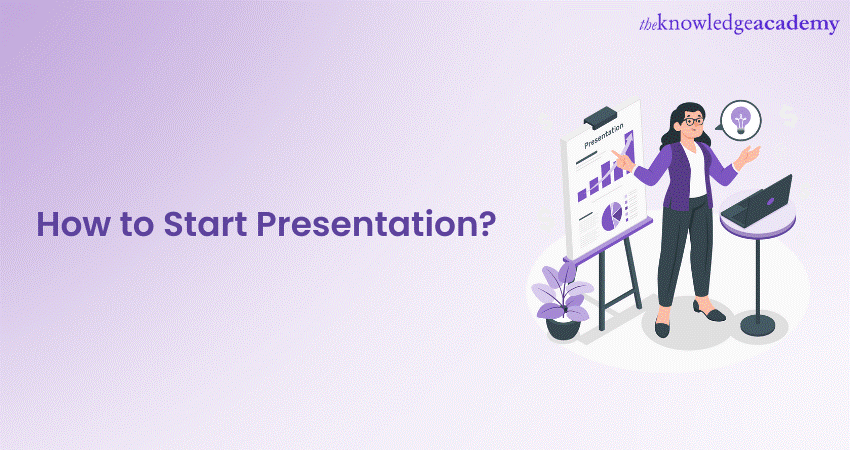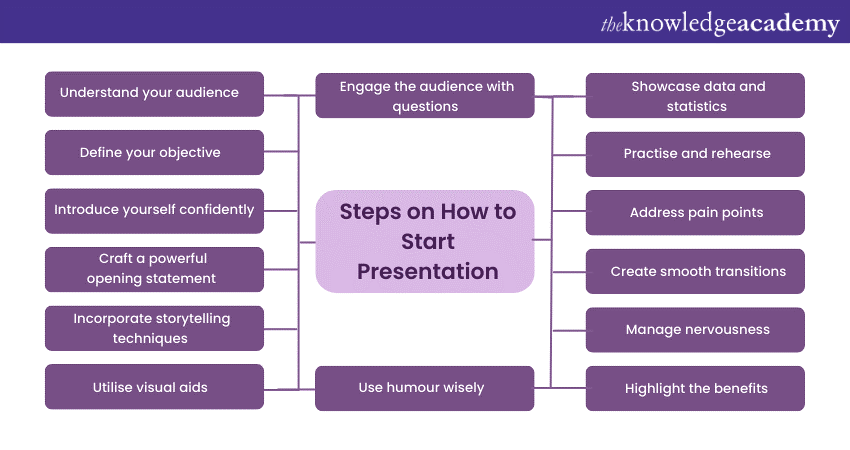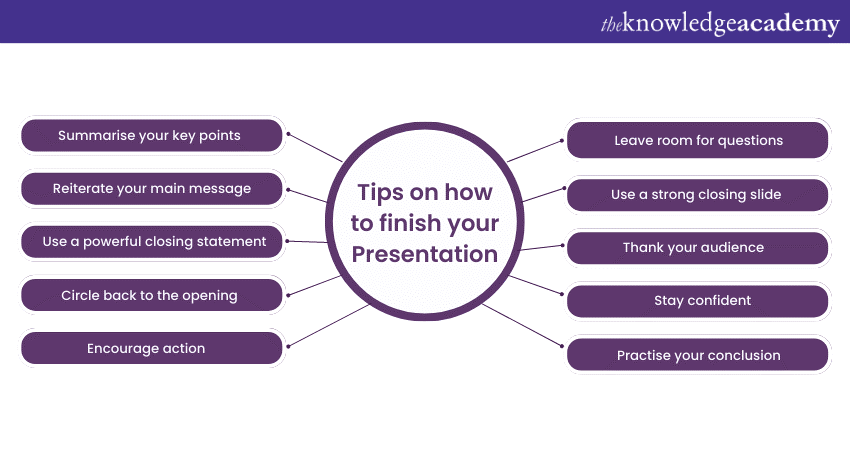We may not have the course you’re looking for. If you enquire or give us a call on 01344203999 and speak to our training experts, we may still be able to help with your training requirements.
Training Outcomes Within Your Budget!
We ensure quality, budget-alignment, and timely delivery by our expert instructors.

When it comes to delivering a Presentation, the beginning is arguably the most crucial part. A strong start can capture your audience's attention, set the tone, and establish your credibility. However, it can be daunting to figure- out How to Start a Presentation effectively. In this blog, we will walk you through the step-by-step process of How to Start a Presentation, and help you craft a compelling introduction for your Presentation. So, read ahead to learn more!
Table of Contents
1) What is an introduction in Presentation?
2) Steps on How to Start a Presentation?
a) Understand your audience
b) Define your objective
c) Introduce yourself confidently
d) Craft a powerful opening statement
e) Incorporate storytelling techniques
f) Utilise visual aids
g) Engage the audience with questions
h) Use humour wisely
i) Showcase data and statistics
j) Create smooth transitions
3) Common mistakes to avoid in the opening of a Presentation
4) Tips on how to finish your Presentation
5) Conclusion
What is an introduction in Presentation?
A Presentation introduction serves as the initial phase of your Presentation, aimed at acquainting your audience with your identity and the topic you will be discussing. It's an opportunity to establish credibility and pique interest.
Steps on How to Start a Presentation?
Let’s learn everything you need to know about How to Start a Presentation, and help you enhance your Presentation Skills. So, consider the following to learn more:

Understand your audience
Before you step up to deliver your Presentation, take the time to understand your audience. Conduct research or surveys to grasp their interests, needs, and prior knowledge related to your topic. By understanding your audience's demographics and preferences, you can tailor your content and approach to resonate with them effectively.
Identify the main demographics of your audience, such as age, gender, educational background, and professional expertise, as a crucial step to prepare a presentation that resonates effectively. Consider what they might already know about your topic and what information would be new or valuable to them. Understanding their expectations and interests will allow you to create a Presentation that meets their needs and keeps them engaged from the outset.
Define your objective
Every successful Presentation must have a clear objective. Ask yourself: What do you want your audience to take away from your talk? Are you aiming to inform, persuade, inspire, or entertain? Defining your objective will serve as a guiding light and help you structure your content coherently.
Consider the primary message that you want to convey and the specific actions or reactions you hope to elicit from your audience. Once you have a clear goal in mind, you can build your Presentation around it. This way you can also ensure that every point and example aligns with your intended outcome.
Introduce yourself confidently
As you step onto the stage or stand before your audience, confidently introduce yourself. Share your name, position, and any relevant qualifications or experience that establish your authority on the topic. A strong introduction not only builds credibility but also creates a sense of trust between you and your audience.
Keep your introduction brief, but don't shy away from mentioning relevant accomplishments or experiences that directly relate to your Presentation. A confident introduction sets a positive tone and signals to your audience that they are in capable hands.
Unlock your full potential as a presenter with our Presentation Skills Training Course – Join now!
Craft a powerful opening statement
The opening moments are critical for capturing your audience's attention. Craft a powerful and attention-grabbing opening statement that sparks curiosity and curiosity. You can begin with a compelling question, a surprising statistic, or a thought-provoking quote.
A robust opening will draw your audience in, letting them hear what comes next. Aim to create an emotional connection or resonate with their interests right from the start, setting the stage for an engaging and impactful Presentation. One must also be aware of the advantages and disadvantages of presentations.
Incorporate storytelling techniques
Humans are naturally drawn to stories. Weave storytelling techniques into your Presentation to create emotional connections with your audience. Share relevant anecdotes, personal experiences, or case studies that illustrate the points you want to make.
A well-crafted story can evoke emotions, making your Presentation memorable and relatable. It helps your audience resonate with your content on a deeper level, increasing their receptiveness to your message.
Utilise visual aids
Visual aids are powerful tools for enhancing your Presentation's impact and clarity. Use slides, images, charts, or videos to visually illustrate complex concepts, data, or processes. Well-designed visuals complement your spoken words and reinforce key points, making them easier to understand and remember.
Remember to keep visual aids simple, uncluttered, and relevant to avoid overwhelming or distracting your audience. Visuals should support your narrative and amplify your message, not compete with it.
Engage the audience with questions
Engaging your audience is crucial for maintaining their attention and involvement. Incorporate rhetorical or interactive questions to encourage participation and critical thinking.
Ask thought-provoking questions that prompt your audience to reflect on the topic or relate it to their own experiences. This fosters a sense of involvement, making your Presentation more interactive and memorable.
Use humour wisely
Appropriate humour can be used as a powerful tool for connecting with your audience and breaking the ice. Use light-hearted anecdotes or witty remarks that align with your content and maintain a professional tone.
Humour can help ease tension, make your Presentation more enjoyable, and create a positive atmosphere. However, avoid jokes that could be offensive or distract from your main message.
Showcase data and statistics
Supporting your points with data and statistics can strengthen your credibility. Use reliable sources to present relevant facts, figures, or research findings that back up your arguments.
Data-driven evidence reinforces your expertise on the subject and adds substance to your talk. It also gives your audience a tangible basis for understanding the importance or relevance of your topic.
Take your Presentations to the next level with our Effective Presentation Skills & Techniques Course – sign up today!
Practise and rehearse
Confidence comes from thorough preparation. Rehearse multiple times to familiarise yourself with the flow and content. Practise in front of a mirror or record yourself to identify areas that need improvement.
Rehearsing helps you refine your delivery, ensure smooth transitions, and become more comfortable with the material. The more you practise, the more confident and natural you will appear during the actual Presentation.
Address pain points
Identify the pain points or challenges your audience may be facing related to your topic. Addressing these concerns early on shows empathy and understanding, making your Presentation more relevant and valuable to your listeners.
Acknowledging their needs and offering solutions or insights builds rapport and trust with your audience. Show them that you understand their struggles and have valuable information to share.
Create smooth transitions
Creating smooth transitions is the art of seamlessly linking ideas and concepts, ensuring a logical and coherent flow. Transitions act as bridges between different sections or points, guiding your audience through the journey of your talk with ease.
To achieve smooth transitions, use transitional words and phrases that indicate shifts in thought or direction. Examples include "now let's move on to," "in addition," "on the other hand," and "finally." Additionally, consider using visual aids or anecdotes to connect ideas smoothly. Slides, images, or short stories can act as visual cues that guide your audience from one topic to another. By carefully crafting transitions, you create a cohesive and engaging Presentation that keeps your listeners attentive and receptive throughout.
Manage nervousness
Feeling nervous before a Presentation is natural and can even be beneficial. Embrace the adrenaline as energy to fuel your enthusiasm and passion for your topic.
Practise relaxation techniques, like deep breathing, to help calm your nerves. Remind yourself that your audience is supportive, and a little nervousness shows that you care about delivering a great Presentation.
Highlight the benefits
Emphasise the benefits your audience will gain from listening to you. Address the "What's in it for me?" question by showcasing how your content is relevant and valuable to their lives or work.
Highlight the practical applications or positive outcomes they can expect from implementing your ideas or recommendations. Demonstrating the value of your Presentation keeps your audience engaged and motivated to act on what they've learned.
Use a powerful quote
Introducing a powerful quote can add credibility and impact to your Presentation. Select a quote from a respected authority or renowned figure in your field that aligns with your audience and encapsulates the essence of your message. A well-chosen quote can inspire, motivate, or challenge your listeners, prompting them to reflect on the significance of your topic and its relevance to their lives or work.
State a bold statement or challenge
Opening with a bold statement or challenge can pique curiosity and provoke thought among your audience. Make a provocative assertion or pose a compelling question that challenges conventional wisdom or prompts re-evaluation of existing beliefs. By presenting a bold statement or challenge at the outset, you can grab attention and set the stage for a thought-provoking discussion that stimulates critical thinking and exploration of new ideas.
Unlock your full potential as a presenter with our Presentation Skills Training – join now!
Pose a problem and offer a solution
Frame your Presentation by highlighting a relevant problem or challenge and then proposing a solution or course of action. Clearly define the problem statement, emphasising its significance and implications.
Then, transition to your proposed solution, outlining its benefits and addressing potential objections. By presenting a clear problem-solving framework, you can demonstrate your expertise and provide actionable insights that resonate with your audience.
Provide a brief outline
Offering a brief outline of your Presentation structure can help orient your audience and set expectations for what's to come. Clearly articulate the main sections or topics you'll cover, along with any key points or themes you'll address within each section. Providing a roadmap upfront allows your audience to follow along more effectively, helping them stay engaged and focused throughout the Presentation.
Begin with a personal connection
Establishing a personal connection with your audience from the outset can foster rapport and trust. Share a brief personal anecdote, relate a relevant experience, or express genuine enthusiasm for your topic. By demonstrating authenticity and relatability, you can create a sense of camaraderie and mutual comprehension that strengthens the bond between you and your audience, enhancing receptiveness to your message.
Common mistakes to avoid in the opening of a Presentation
Now, that you know How to Start a Presentation, let’s check the common mistakes to avoid. In the initial moments of a Presentation, it's crucial to captivate your audience and set the tone for a successful delivery. Avoiding common pitfalls can ensure a strong start and engage your audience from the starting. Let's see what should not be done:
Starting with apologies
Beginning a Presentation with apologies can undermine your credibility and detract from your message. Instead, focus on projecting confidence and enthusiasm, acknowledging any minor hiccups gracefully, if necessary, but swiftly transitioning to the core content.
Reading from slides
Relying too heavily on reading directly from slides can result in a lacklustre Presentation and disengage your audience. Instead, use slides as visual aids to complement your spoken points, providing additional context or highlighting key takeaways to reinforce your message.
Overwhelming with information
Bombarding your audience with excessive information right from the start can overwhelm them and hinder comprehension. Opt for a concise and structured approach, gradually introducing key concepts and building upon them throughout the Presentation to maintain audience engagement and understanding.
Ignoring the audience
Failing to acknowledge or connect with your audience can create a disconnect and diminish their interest in the Presentation. Start by establishing rapport through a warm greeting or a brief introduction, and strive to maintain audience engagement through eye contact, interactive elements, and addressing their interests and concerns.
Lack of clarity
Unclear or ambiguous communication at the beginning of a Presentation can confuse your audience and undermine the effectiveness of your message. Prioritise clarity in your opening remarks, clearly articulating the purpose, objectives, and structure of your Presentation to provide a roadmap for your audience to follow.
Skipping the hook
Refrain from grabbing your audience's attention with a compelling hook or opening statement to avoid a lacklustre start to your Presentation. Begin with a thought-provoking question, a startling statistic, a relevant anecdote, or a captivating visual to pique curiosity and draw your audience into the topic, setting the stage for a memorable and impactful Presentation.
Take your Presentations to the next level with our Effective Presentation Skills & Techniques Course – sign up today!
Tips on how to finish your Presentation
Now let's explore how to conclude a Presentation. Here are some tips on how to finish your Presentation with impact:

1) Summarise your key points: Begin your conclusion by summarising the main points you covered. This helps reinforce the key takeaways and ensures that your audience remembers the most important aspects of your talk.
2) Reiterate your main message: Restate your central message or call to action clearly and concisely. Emphasise why your topic is relevant and why your audience should care about it.
3) Use a powerful closing statement: End with a memorable closing statement that encapsulates the essence of your talk. This could be a thought-provoking quote, a powerful statistic, or a compelling question that lingers in your audience's mind.
4) Circle back to the opening: If you started your Presentation with an attention-grabbing anecdote or question, consider revisiting it in your conclusion. Connecting the end to the beginning creates a sense of closure and completeness.
5) Encourage action: Motivate your audience to take action based on the information you've shared. Whether it's implementing your recommendations, seeking more information, or joining a cause, inspire them to act on what they've learned.
6) Leave room for questions: Before you conclude, let your audience know that you welcome questions or further discussions. This encourages engagement and shows that you are open to addressing any lingering doubts or curiosities.
7) Use a strong closing slide: End with a visually appealing and impactful closing slide. Include your main message, contact information, or any relevant call-to-action buttons.
8) Thank your audience: Express gratitude to your audience for their time and attention. Acknowledge their presence and let them know that you appreciate their interest in your topic.
9) Stay confident: Maintain a confident and positive demeanour throughout your conclusion. Your body language and tone of voice should reflect your enthusiasm for the topic and your belief in the importance of your message.
10) Practise your conclusion: Just like the rest of your Presentation, rehearse your conclusion to ensure a smooth and impactful delivery. A well-practised conclusion will leave a lasting impression on your audience.
Conclusion
Crafting an impactful Presentation requires a combination of thoughtful preparation and effective delivery. By understanding your audience, defining your objectives, and incorporating engaging techniques such as storytelling and visual aids, you can Improve Your Presentation Skills and captivate your listeners from the start. Practising and addressing pain points further enhance your credibility and connection with the audience. Hope we provided you with all the information you needed to know about How to Start Presentation!
Want to master the art of impactful Presentations? Explore our Presentation Skills Courses and elevate your communication prowess!
Frequently Asked Questions

While memorising can ensure a polished start, focus on understanding and connecting with your audience. Familiarise yourself with key points, allowing flexibility for natural delivery and engagement. Remember, authenticity breeds connection, fostering a genuine rapport with your audience from the outset.

Seamless transitions are pivotal. Use attention-grabbing statements, anecdotes, or questions to bridge the opening to the main content. Maintain coherence, guiding your audience smoothly into the heart of your Presentation. A well-crafted transition sets the stage for an engaging discourse, retaining the audience's attention effectively.

The Knowledge Academy takes global learning to new heights, offering over 30,000 online courses across 490+ locations in 220 countries. This expansive reach ensures accessibility and convenience for learners worldwide.
Alongside our diverse Online Course Catalogue, encompassing 17 major categories, we go the extra mile by providing a plethora of free educational Online Resources like News updates, Blogs, videos, webinars, and interview questions. Tailoring learning experiences further, professionals can maximise value with customisable Course Bundles of TKA.

The Knowledge Academy’s Knowledge Pass, a prepaid voucher, adds another layer of flexibility, allowing course bookings over a 12-month period. Join us on a journey where education knows no bounds.

The Knowledge Academy offers Presentation Skills Courses including Presentation skills, business writing, etc. These courses cater to different skill levels, providing comprehensive insights into Principles of Presentation.
Our Business Skills Blogs covers a range of topics related to Presentation Skills, offering valuable resources, best practices, and industry insights. Whether you are a beginner or looking to advance your Presentation skills, The Knowledge Academy's diverse courses and informative blogs have you covered.
Upcoming Business Skills Resources Batches & Dates
Date
 Presentation Skills Training
Presentation Skills Training
Fri 2nd Aug 2024
Fri 6th Sep 2024
Fri 4th Oct 2024
Fri 1st Nov 2024
Fri 6th Dec 2024
Fri 3rd Jan 2025
Fri 7th Mar 2025
Fri 2nd May 2025
Fri 4th Jul 2025
Fri 5th Sep 2025
Fri 7th Nov 2025







 Top Rated Course
Top Rated Course



 If you wish to make any changes to your course, please
If you wish to make any changes to your course, please


